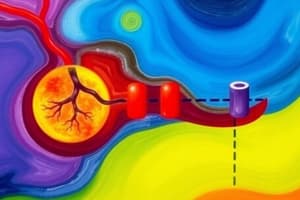Podcast
Questions and Answers
Describe the process of cellular respiration.
Describe the process of cellular respiration.
It is the process that releases energy by breaking down food molecules in the presence of oxygen. The equation is: oxygen + glucose → carbon dioxide + water + energy.
What are the products of glycolysis?
What are the products of glycolysis?
The process in which one molecule of glucose is broken in half, producing two molecules of pyruvic acid.
Name the two main types of fermentation.
Name the two main types of fermentation.
Alcoholic fermentation and lactic acid fermentation.
What is a calorie?
What is a calorie?
How is the function of NAD⁺ similar to that of NADP⁺?
How is the function of NAD⁺ similar to that of NADP⁺?
How are lactic acid fermentation and alcoholic fermentation similar?
How are lactic acid fermentation and alcoholic fermentation similar?
What happens to pyruvic acid during the Krebs cycle?
What happens to pyruvic acid during the Krebs cycle?
How does the electron transport chain use the high-energy electrons from the Krebs cycle?
How does the electron transport chain use the high-energy electrons from the Krebs cycle?
Why is cellular respiration considered to be much more efficient than glycolysis alone?
Why is cellular respiration considered to be much more efficient than glycolysis alone?
How many molecules of ATP are produced in the entire breakdown of glucose?
How many molecules of ATP are produced in the entire breakdown of glucose?
List in order the structures of the respiratory system through which air passes from the outside to the alveoli.
List in order the structures of the respiratory system through which air passes from the outside to the alveoli.
Describe some of the health problems caused by smoking tobacco.
Describe some of the health problems caused by smoking tobacco.
Explain the process of gas exchange in the lungs.
Explain the process of gas exchange in the lungs.
Describe how breathing is controlled.
Describe how breathing is controlled.
Describe the process of photosynthesis, including the reactants and products.
Describe the process of photosynthesis, including the reactants and products.
Why are light and chlorophyll needed for photosynthesis?
Why are light and chlorophyll needed for photosynthesis?
Why are plants green?
Why are plants green?
How well would a plant grow under pure yellow light? Explain your answer.
How well would a plant grow under pure yellow light? Explain your answer.
Flashcards are hidden until you start studying
Study Notes
Cellular Respiration
- Releases energy by breaking down food molecules in the presence of oxygen.
- Equation: oxygen + glucose → carbon dioxide + water + energy.
Glycolysis
- Initial stage of cellular respiration.
- One glucose molecule is split, producing two pyruvic acid molecules.
Fermentation
- Two main types: alcoholic fermentation and lactic acid fermentation.
Calorie Definitions
- A calorie raises the temperature of 1 gram of water by 1°C.
- A Calorie on food labels equals 1000 calories (kilocalorie).
NAD⁺ and NADP⁺ Functionality
- Both transport high-energy electrons; NAD⁺ in cellular respiration and NADP⁺ in photosynthesis.
Comparison of Fermentations
- Alcoholic fermentation converts pyruvate to carbon dioxide and ethanol, used in making wine and beer.
- Lactic acid fermentation converts pyruvate to lactic acid; both are types of anaerobic respiration.
Krebs Cycle
- Pyruvic acid is broken down into carbon dioxide through a series of reactions, extracting energy.
Electron Transport Chain
- Utilizes high-energy electrons from the Krebs cycle to convert ADP into ATP.
Efficiency of Cellular Respiration
- Cellular respiration yields over 30 ATP compared to the 2 ATP from glycolysis, making it significantly more efficient.
ATP Production
- Aerobic respiration produces 36 ATP from glucose breakdown; anaerobic produces only 2 ATP.
Respiratory System Pathway
- Air flow: nose/mouth → pharynx → larynx → trachea → bronchi → lungs → alveoli.
Health Issues from Smoking
- Causes respiratory diseases: chronic bronchitis, emphysema, lung cancer.
Gas Exchange Process
- Oxygen diffuses from alveoli into the blood; carbon dioxide diffuses from blood into alveoli.
Breathing Control
- Driven by air pressure and the diaphragm; controlled by the nervous system for automatic regulation.
Photosynthesis
- Converts water and carbon dioxide into oxygen and high-energy sugars, requiring light and chlorophyll.
Role of Light and Chlorophyll
- Chlorophyll absorbs light energy, essential for driving photosynthesis.
Plant Coloration
- Plants appear green because chlorophyll reflects green light rather than absorbing it.
Plant Growth Under Yellow Light
- Effectiveness may be reduced; plants absorb red and blue light better than yellow for optimal photosynthesis.
Studying That Suits You
Use AI to generate personalized quizzes and flashcards to suit your learning preferences.




